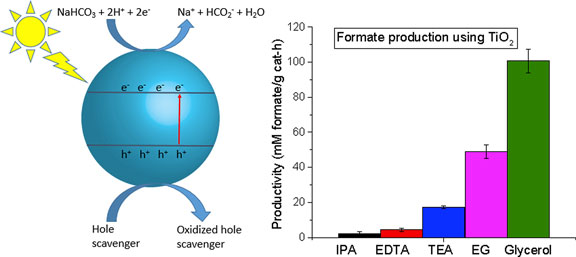Crossref Citations
This article has been cited by the following publications. This list is generated based on data provided by
Crossref.
Jia, Yulong
Wang, Zhonghao
Wang, Luyang
Ma, Ying
Wang, Guannan
Lin, Yinhe
Hu, Xun
and
Zhang, Kan
2019.
Awakening Solar Hydrogen Evolution of MoS2 in Alkalescent Electrolyte through Doping with Co.
ChemSusChem,
Vol. 12,
Issue. 14,
p.
3336.
Khalil, Munawar
Pratama, Reza Imam
Sujak, Muhammad
Garry, Alexander
Djuhana, Dede
Umar, Aminah
Lai, Chin Wei
and
Jan, Badrul Mohamed
2020.
Dependence of the photocatalytic reduction of bicarbonate to formic acid by Au–TiO2 on Au morphology and its plasmonic vibrational mode.
Materials Chemistry and Physics,
Vol. 249,
Issue. ,
p.
123018.
Khalil, Munawar
Rangkuti, Talitha H.
Naumi, Fadlinatin
Gunlazuardi, Jarnuzi
Ivandini, Tribidasari A.
Kadja, Grandprix T.M.
and
Mulyana, Jacob Y.
2020.
A synergy of CdSe sensitization and exposure of TiO2 (0 0 1) facet in CdSe-TiO2 nanostructures for photoreduction of bicarbonate.
Inorganic Chemistry Communications,
Vol. 118,
Issue. ,
p.
107992.
Lyu, Pin
and
Nguyen, Son C.
2021.
Effect of Photocharging on Catalysis of Metallic Nanoparticles.
The Journal of Physical Chemistry Letters,
Vol. 12,
Issue. 51,
p.
12173.
Zhou, Shiwen
Wu, Qian
Wang, Zhiguo
Liang, Qiuju
and
Lu, Hongmei
2021.
Photocatalytic reduction-based liquid microjunction surface sampling–mass spectrometry for rapid in situ analysis of aromatic amines originating from azo dyes in packaging papers.
Analytical and Bioanalytical Chemistry,
Vol. 413,
Issue. 26,
p.
6649.
Van Dao, Dung
Cipriano, Luis A.
Di Liberto, Giovanni
Nguyen, Thuy T. D.
Ki, Sang-Woo
Son, Hoki
Kim, Gyu-Cheol
Lee, Kang Hyun
Yang, Jin-Kyu
Yu, Yeon-Tae
Pacchioni, Gianfranco
and
Lee, In-Hwan
2021.
Plasmonic Au nanoclusters dispersed in nitrogen-doped graphene as a robust photocatalyst for light-to-hydrogen conversion.
Journal of Materials Chemistry A,
Vol. 9,
Issue. 40,
p.
22810.
Wang, Yanjie
and
He, Tao
2021.
Recent advances in and comprehensive consideration of the oxidation half reaction in photocatalytic CO2 conversion.
Journal of Materials Chemistry A,
Vol. 9,
Issue. 1,
p.
87.
Pan, Hanqing
Premachandra, Dumindu
and
Heagy, Michael D.
2022.
Artificial foliage with remarkable quantum conversion efficiency in bicarbonate to formate.
Sustainable Energy & Fuels,
Vol. 6,
Issue. 2,
p.
267.
Nguyen, Van-Can
Nimbalkar, Dipak B.
Hoang Huong, Vu
Lee, Yuh-Lang
and
Teng, Hsisheng
2023.
Elucidating the mechanism of photocatalytic reduction of bicarbonate (aqueous CO2) into formate and other organics.
Journal of Colloid and Interface Science,
Vol. 649,
Issue. ,
p.
918.
Du, Zisheng
Gong, Kexin
Yu, Zhiruo
Yang, Yang
Wang, Peixian
Zheng, Xiuzhen
Wang, Zhongliao
Zhang, Sujuan
Chen, Shifu
and
Meng, Sugang
2023.
Photoredox Coupling of CO2 Reduction with Benzyl Alcohol Oxidation over Ternary Metal Chalcogenides (ZnmIn2S3+m, m = 1–5) with Regulable Products Selectivity.
Molecules,
Vol. 28,
Issue. 18,
p.
6553.
Yilmaz, Bengisu
and
Ünal, Uğur
2024.
Photoelectrochemical Investigation of Hole Scavengers for Photocatalytic Hydrogen Evolution Reaction on Perovskite‐Type Niobate Nanosheets.
ChemPhotoChem,
Chittoory, Valli Kamala Laxmi Ramya
Filipsika, Marketa
Bartoš, Radim
Králová, Marcela
and
Dzik, Petr
2024.
Physicochemical Properties of Tungsten Trioxide Photoanodes Fabricated by Wet Coating of Soluble, Particulate, and Mixed Precursors.
Photochem,
Vol. 4,
Issue. 1,
p.
111.
Najafi, At-har
Darbandi, Masih
and
Zarei, Mahmoud
2025.
Enhanced sonophotocatalytic degradation of phenazopyridine using mesoporous nickel oxide nanoparticles synthesized by a solvothermal method in deep eutectic solvent.
Journal of Molecular Liquids,
Vol. 417,
Issue. ,
p.
126664.
Ramos, Caroline M.V.P.
Costa, Antônio G.R.
Silva, Maria K.
Antunes, Renato A.
Silva, Lara K.R.
Silva, Rejane M.P.
Cavalcante, Laecio S.
and
Santos, Reginaldo S.
2025.
Tandem cell configured with n-WO3|p-CuBi2O4 junction for water splitting.
Surfaces and Interfaces,
Vol. 56,
Issue. ,
p.
105656.
